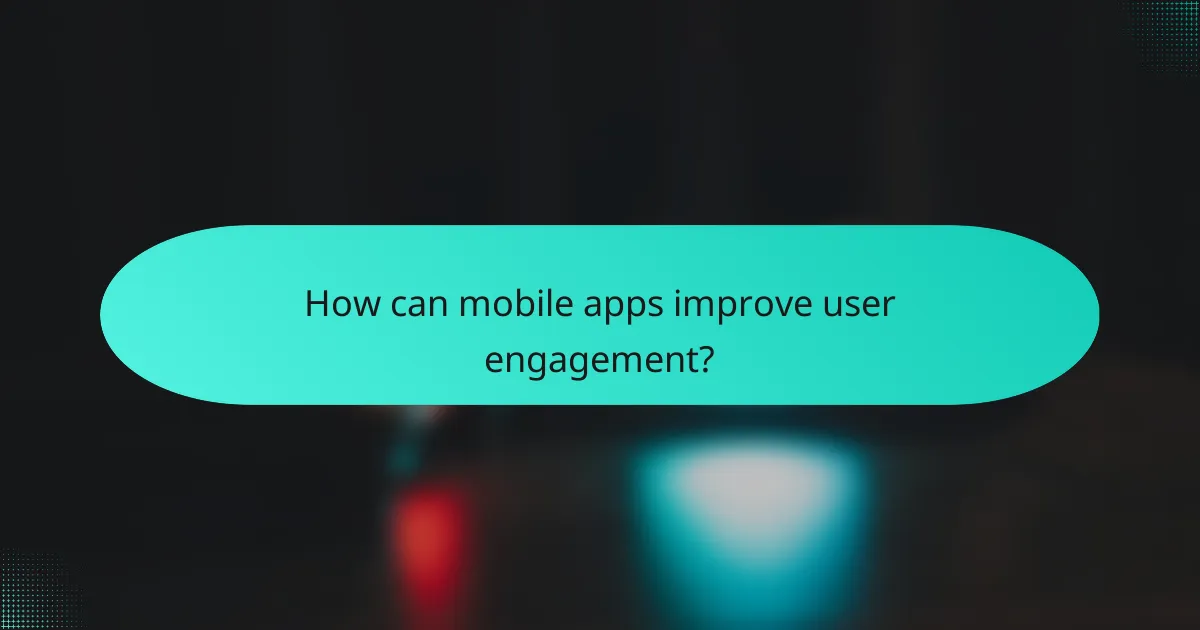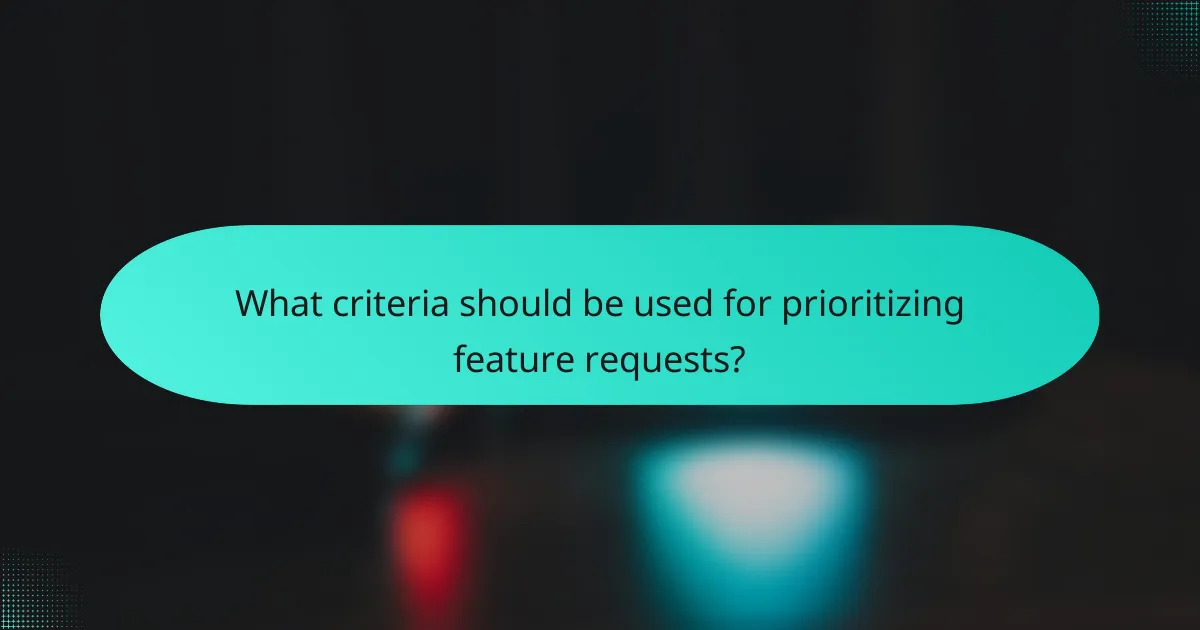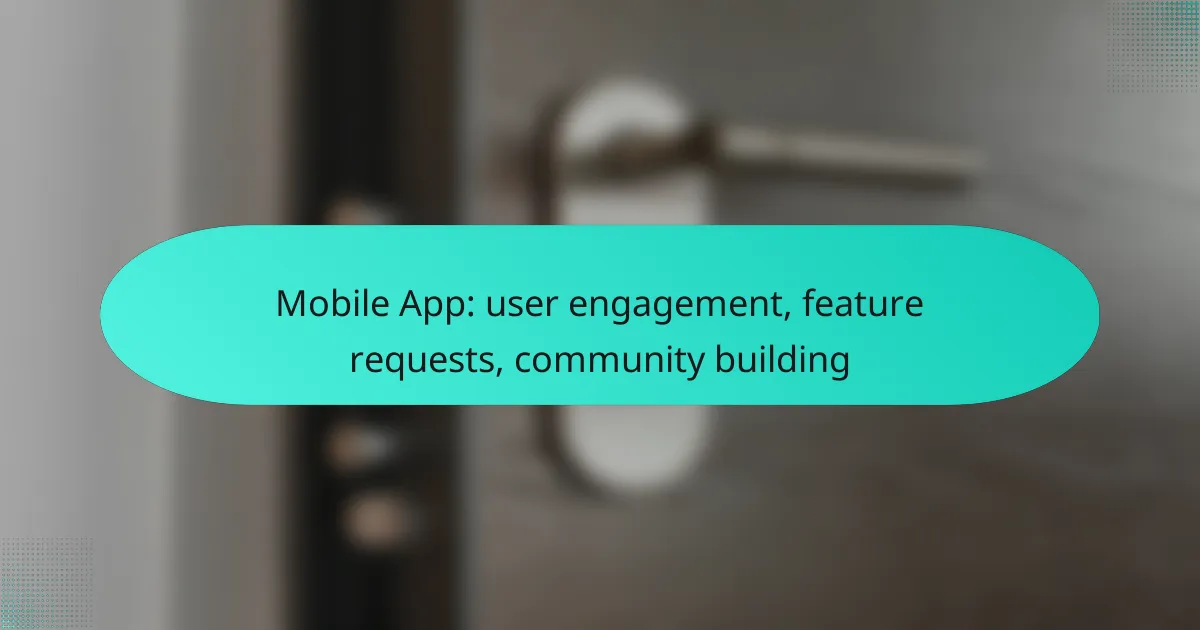Enhancing user engagement in mobile apps requires strategic implementation of interactive features that resonate with users. By actively soliciting feature requests and fostering a vibrant community, developers can create a loyal user base that feels valued and heard. This approach not only boosts retention but also drives continuous improvement through direct user feedback.

How can mobile apps improve user engagement?
Mobile apps can enhance user engagement by implementing strategies that foster interaction and satisfaction. Key methods include personalized notifications, gamification techniques, user feedback integration, regular content updates, and social sharing features.
Personalized notifications
Personalized notifications are tailored messages that inform users about relevant updates or offers based on their behavior and preferences. These notifications can significantly increase user engagement by reminding them of features they may find valuable or alerting them to new content that aligns with their interests.
To implement effective personalized notifications, analyze user data to segment your audience. Avoid overwhelming users with too many alerts; instead, focus on quality and relevance to maintain user interest.
Gamification techniques
Gamification involves incorporating game-like elements into the app experience to motivate users. Techniques such as points, badges, and leaderboards can create a sense of achievement and competition, encouraging users to engage more frequently with the app.
Consider integrating challenges or rewards that align with user goals. For example, fitness apps often use gamification to encourage users to complete workouts, making the experience more enjoyable and engaging.
User feedback integration
Integrating user feedback allows app developers to understand user needs and preferences better. By actively soliciting and implementing feedback, apps can evolve in ways that resonate with their audience, fostering a sense of community and ownership among users.
Utilize surveys, in-app feedback forms, or community forums to gather insights. Make sure to communicate any changes made based on user suggestions to reinforce that their input is valued.
Regular content updates
Regular content updates keep the app fresh and engaging, encouraging users to return frequently. This can include new features, articles, or seasonal promotions that align with user interests and current trends.
Establish a content calendar to plan updates and maintain consistency. Inform users about upcoming changes through notifications or newsletters to build anticipation and excitement.
Social sharing features
Social sharing features enable users to share their experiences or achievements within the app on social media platforms. This not only enhances user engagement but also serves as a marketing tool, attracting new users through organic recommendations.
Incorporate easy-to-use sharing options and encourage users to share their milestones or favorite content. Consider offering incentives, such as discounts or exclusive content, for users who share the app with their networks.

What are effective methods for gathering feature requests?
Effective methods for gathering feature requests include leveraging in-app surveys, user forums, beta testing groups, and feedback forms. These approaches facilitate direct communication with users, allowing you to understand their needs and preferences better.
In-app surveys
In-app surveys are quick questionnaires integrated into the app, prompting users to share their thoughts on features. They can be triggered after specific actions, like completing a task or reaching a milestone, ensuring timely feedback. Aim for concise surveys with 3-5 questions to maximize response rates.
Consider using multiple-choice questions for quick responses and open-ended questions for deeper insights. Offering small incentives, such as in-app rewards, can also boost participation.
User forums
User forums provide a platform for users to discuss their ideas and suggestions openly. By creating a dedicated space within your app or website, you encourage community engagement and allow users to interact with each other. This can lead to a wealth of ideas and insights from diverse perspectives.
Moderate the forum to ensure constructive discussions and highlight popular requests. Regularly review the forum to identify trends and prioritize feature development based on user interest.
Beta testing groups
Beta testing groups consist of selected users who test new features before their official release. This method allows you to gather direct feedback on usability and functionality, ensuring the features meet user expectations. Choose a diverse group of testers to gain varied insights.
Communicate clearly with beta testers about what you need feedback on, and provide them with easy channels to report issues or suggestions. This can significantly enhance the final product based on real user experiences.
Feedback forms
Feedback forms are straightforward tools for users to submit their feature requests and suggestions. These can be embedded within the app or sent via email, making it easy for users to share their thoughts at their convenience. Keep the forms simple, focusing on key questions that guide users in providing relevant information.
Regularly analyze the feedback collected to identify common themes and prioritize requests. Consider implementing a system to acknowledge user submissions, which can foster a sense of community and encourage ongoing engagement.

How can community building enhance mobile app success?
Community building can significantly enhance mobile app success by fostering user loyalty and encouraging engagement. A strong community creates a sense of belonging among users, leading to increased retention and valuable feedback on features and improvements.
Creating user groups
Establishing user groups allows app users to connect based on shared interests or demographics. These groups can be formed on platforms like Facebook or Discord, where users can share experiences, tips, and suggestions. This interaction not only strengthens community ties but also provides direct insights into user preferences and feature requests.
Consider segmenting user groups by app usage patterns or specific features. For example, a fitness app might create groups for beginners, intermediate users, and advanced athletes. This targeted approach can lead to more relevant discussions and tailored content.
Hosting events and webinars
Hosting events and webinars can engage users and provide them with valuable information about the app. These events can range from tutorials and Q&A sessions to community challenges and competitions. Such activities not only educate users but also encourage them to interact with each other and the app developers.
For effective events, consider scheduling them at times that accommodate your user base, and use platforms that are easily accessible. Offering incentives, like exclusive features or rewards, can also boost participation and excitement.
Social media engagement
Active social media engagement is crucial for building a vibrant app community. Regularly posting updates, user stories, and interactive content can keep users informed and involved. Platforms like Instagram, Twitter, and TikTok are effective for showcasing user-generated content and app features.
Encourage users to share their experiences with your app on social media by creating branded hashtags or running contests. This not only promotes user engagement but also attracts new users through organic reach.
Content creation by users
Encouraging users to create content related to your app can significantly enhance community building. This can include reviews, tutorials, or creative uses of the app. User-generated content not only fosters a sense of ownership but also provides authentic testimonials that can attract new users.
To facilitate content creation, consider implementing features that allow users to easily share their experiences within the app. Highlighting top contributors in newsletters or on social media can also motivate others to participate and share their own content.

What criteria should be used for prioritizing feature requests?
Prioritizing feature requests involves evaluating user demand, the potential impact on user retention, and the associated development costs. These criteria help ensure that the most valuable features are implemented efficiently, aligning with user needs and business goals.
User demand analysis
User demand analysis focuses on understanding what features users want the most. Gathering feedback through surveys, app reviews, and user interviews can reveal trends and preferences. Prioritize requests that receive the highest frequency or intensity of interest, as these are likely to enhance user satisfaction.
Utilizing tools like heatmaps or analytics can also help identify which existing features are underused, guiding you to understand what new functionalities could drive engagement. Consider creating a voting system where users can express their preferences for proposed features.
Impact on user retention
The impact of a feature on user retention is critical in prioritization. Features that address pain points or enhance user experience can significantly reduce churn rates. Analyze user behavior data to determine which features correlate with longer app usage or increased session frequency.
For example, if users frequently request a streamlined onboarding process, implementing this feature could lead to higher retention rates among new users. Always consider the long-term benefits of features that foster loyalty over short-term gains.
Development cost assessment
Development cost assessment evaluates the resources required to implement a feature. This includes time, budget, and technical complexity. Features that are high in demand but low in cost should be prioritized, as they provide a good return on investment.
Consider using a scoring system to rate features based on their expected impact and development costs. For instance, features that can be developed within a few weeks and have a high user demand should take precedence over more complex projects that may take months to complete.

How can app analytics inform user engagement strategies?
App analytics can significantly enhance user engagement strategies by providing insights into user behavior, preferences, and pain points. By analyzing data, developers can tailor features and improve the overall user experience, fostering greater retention and satisfaction.
Tracking user behavior
Tracking user behavior involves monitoring how users interact with an app, including which features they use most frequently and how long they spend in the app. This data can be collected through various analytics tools that record user actions, such as clicks, scrolls, and navigation paths.
Understanding user behavior helps identify popular features and areas that may need improvement. For example, if users frequently engage with a specific feature, developers can enhance it further, while less-used features may require reevaluation or removal.
Identifying drop-off points
Identifying drop-off points refers to recognizing where users abandon the app or stop completing desired actions, such as making a purchase or signing up for a newsletter. Analyzing these points can reveal obstacles in the user journey that may hinder engagement.
Common drop-off points often occur during complex processes, such as registration or checkout. By simplifying these steps or providing additional guidance, developers can improve user retention and encourage more users to complete their intended actions.
Measuring feature usage
Measuring feature usage involves assessing how often specific functionalities are utilized within the app. This metric helps determine which features are valuable to users and which may need enhancement or redesign.
Developers can use this data to prioritize updates based on user needs. For instance, if a new feature is underused, it may indicate that users are unaware of it or that it does not meet their expectations. Regularly reviewing feature usage can guide effective development and marketing strategies.
